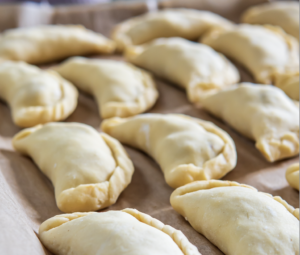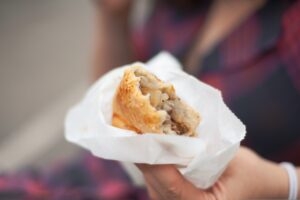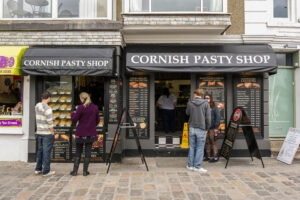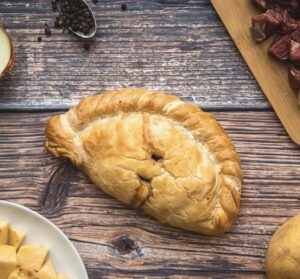features
The history of the Cornish pasty – one of the UK’s ultimate comfort foods
15 Sept 2022
10m
Nobody can deny the impact of the Cornish Pasty. Once little more than a practical, local snack, it’s now one of the UK’s most beloved comfort foods – and it’s not hard to see why.
Warm, filling and packed full of hearty meat and veg, the pasty is no frills, it’s affordable and it’s filling. It doesn’t get much better than that, does it?
But do you ever wonder where the Cornish pasty originated from? Who is responsible for creating such a masterpiece, and how has the humble pasty evolved to be what it is today?
We’ve done some digging into the Cornish pasty and its history, and it’s actually pretty fascinating…

The cornish pasty is one of the UK’s most beloved comfort foods (Credit: Alamy)
What is a Cornish Pasty?
Before we go any further, we need to establish one important fact – what the Cornish pasty actually is.
You see, you might think you know, but the chances are you haven’t nailed down the specifics. Let us break it down.
Made out of pastry which is folded in a crescent d-shape, and crimped on one side, a Cornish pasty is filled with raw meat and veg, and slow baked to create that flaky, carby outer shell and oozey, gravy-like filling we know and love.
Believe it or not, the Cornish pasty is such a sacred British comfort food that it has been awarded Protected Geographical Indication status, which means its definition is unchangeable, in order to protect its “quality and reputation”.
The status has also been given to the likes of Gorgonzola, Parmigiano-Reggiano cheese and Champagne – so, basically, all the good stuff.
But it’s a pretty serious label, dictating that if you don’t ensure at least one part of the production takes place in Cornwall itself, and cook it exactly as intended, it cannot be defined as a Cornish pasty.
Speaking to Twisted, Jason Jobling, chairman of the Cornish Pasty Association, which campaigned for nine years to get the accolade, says: “This protection is so important to protect the pasty, and make sure it’s there for other generations.”
We’ll get into the specifics of what makes a Cornish pasty below…

There are some very strict requirements of a Cornish Pasty (Credit: Unsplash)
What is in a traditional Cornish pasty?
Get ready for some very fine details, here. According to the Cornish Pasty Association, a traditional Cornish pasty is meant to have no less than 12.5 percent meat and 25 percent veg in its filling, otherwise, you better be calling it something else.
The reason there’s more veg than meat in there is because meat used to be much more expensive back when pasties were first being consumed in the 17th and 18th century, so people would load them with cheaper root veg to bulk them out.
The ingredients you must put in a traditional Cornish pasty are as follows:
- Roughly diced or minced beef
- Sliced or diced potato
- Swede (turnip)
- Onion
- Seasoning to taste (mainly salt & pepper)
And (you’re probably getting the gist now), “anything else shouldn’t be in it”, says Jason. That means no variations on the meat or the veg if you wanna keep it traditional.
“Over time, when it was going through [wider] production, there were a lot of pasties which were machine made, had peas and carrots in, and didn’t really follow the traditional recipe. That’s all stopped now,” he says. “They can call it a pasty, but not a Cornish pasty”.
There are a few other requirements for a Cornish pasty filling, too. The veg is meant to be ‘chunky’ and the meat should be “minced or roughly chopped”. Plus, all the ingredients should go into the pastry uncooked, so that they gradually bake within it.
Variations of the pasty
Despite the rather rigorous guidelines, Jason, of the Cornish Pasty Association, says there is leeway for people to experiment with fats, using cream, butter or even beef suet to make their pasty richer and more indulgent.
Plus, seasoning is a vital part of the pasty, and is where bakers can really stand out from each other. Salt, pepper and herbs are all encouraged to make the flavours sing.
Of course, as important as tradition is, today, even the most long-standing Cornish pasty shops have their own variations on the snack, as the market has grown and evolved over the years.
For one, Andrew Cane, area manager of Warren’s, the first bakery in Cornwall to ever sell the pasty back in 1860, tells Twisted: “For our Cornish pasties, we still use our traditional recipe that we’ve used since the beginning, and that will never change.
“But we’ve tried basically everything that you can put in the pasty over the years. We’ve got vegetable pasties with cheese and onion, we’ve got chicken, Thai vegan, original vegan, pork and cider, steak and ale, beef and Stilton…you name it, we’ve tried it.”

Cornish pasties used to be eaten by miners (Credit: Pexels)
They’re not alone, either. Cornish pasty company, Ginsters, has a Bombay potato and spinach offering as well as a vegan Quorn filling, whilst many other local Cornish shops sell their own variations.
“We get told ‘that’s not a pasty’,” the manager of Warrens laughs. “But we recognise that today you have to have a wide ranging offering which appeals to all sorts of customers”.
You might not be able to call it a Cornish pasty, but it’s still very much inspired by one. A Cornish pasty’s sibling, if you will…
What pastry do you use for a Cornish pasty?
As for the pastry used in a Cornish pasty, there’s a little bit more flexibility. The Cornish Pasty Association say that people can use shortcrust, rough puff or puff pastry to make their pasty.
“Originally, it just started off with the shortcrust pastry [because it is] really robust and easier to make,” says Jason. “But over time that’s developed. Some people like a lighter, flakier pastry now.”
The main criteria is that the pasty is savoury and is able to withstand being handled without breaking. After all, nobody wants chunky meat bouncing off their crocs as they try to take a bite, do they?
The Cornish Pasty Association suggest glazing your pasty with egg, milk or both in order to give it that golden just baked glow.
Anyone else suddenly very hungry?!

Anyone else fancy a pasty now? (Credit: Unsplash)
Where do pasties originate from?
Though the exact date of the pasty’s emergence is unknown, we know they were around in the 13th Century, according to cookbooks and documentation from the era.
The pasties back then were rather different to the Cornish pasty we’d think of today, though. They started off more like pies, inspired by the Mediaeval French word for pie, “paste”, and tended to be enjoyed by the royal circles and upper classes because of the ingredients used.
Subsequently, Henry VII’s wife, Jane Seymour was documented to have written about pasties in a letter and there’s even reference to them in Shakespeare’s All’s Well That Ends Well, within the rather fun line: “I will confess to what I know without constraint: if ye pinch me like a pasty, I can say no more”.
However, around the 17th century, references to pasties declined everywhere except Cornwall… and one other place – Devon.
Did the pasty come from Cornwall or Devon?
It’s the age old debate…did the pasty as we know it today come from Cornwall or Devon? The answer isn’t really clear cut.
Whilst it’s generally accepted that the pasty as we know it today originated in Cornwall, and indeed the Cornish pasty makes up 6 percent of the region’s economy, historian Dr Todd Gray is one such historian who is adamant we’ve got it wrong.
He claims that the traditional pasty was first mentioned in Devon, after scouring historic Audit Books and Receivers Accounts in Plymouth and spotting a line he believes references the cost of making pasties.
Whilst this may well be true, The Cornish Pasty Association argue that semantics of where the pasty was mentioned first are futile, since they date back so far beyond either of their regions. Plus, the recipe Dr Gray mentions also references venison, so is likely an iteration of the French pies mentioned above rather than a pasty as we know one today.
They go on to state that nobody can argue how Cornwall popularised the pasty around the globe, or with the fact that pasties were widespread in Cornwall throughout the 18th and 19th century.
“Everybody can lay claim down but ultimately, we believe the pasty originated in Cornwall and it’s so valuable to Cornwall now,” says Jason, a little tentatively.
It’s clear the two regions are going to be arguing about this one until the end of time…

The Cornish Pasty is hugely popular across the UK (Credit: Alamy)
What is the history of the Cornish Pasty?
The history of the Cornish pasty is the really interesting part. Whilst the pasty had been around before, the Cornish pasty came into its own in the 17th and 18th century, when it became the meal of choice for working class tin miners in Cornwall.
Once elaborate and decadent, the pasty took on a new role at this point, adopted because it was an affordable way to turn meat and veg into a hearty meal.
Jason says it wasn’t uncommon for miner’s wives to put veg from the local fields and even rabbit meat or fish inside pasties at the very beginning, if money was tight. In fact, an old saying joked ‘the Devil would never cross the river into Cornwall because he’d be baked into a pasty’, making light of the Cornish wives thriftiness.
“They became the original fast food, in a way, because they’re so great at travelling. So they used to take them down the mines because they were so versatile. They’d stay hot, they were filling and cheap to make,” he adds. “They worked really hard and needed a really wholesome dish.
“The miners used to hold them by the crimp because they had dirty hands and had arsenic and stuff on their hands, so they used to throw them away, and [an old wives tale suggests] that used to keep the pixies happy in the mines!”
Other historians argue instead that miners wrapped their Cornish pasties in paper bags or muslins so they could eat all of it, including the crimp. The likelihood is it was a mixture of the two.
There are copious old pictures of miners holding what look to be Cornish pasties to verify that it was their meal of choice, and, indeed, it even goes some way to explaining the pasty’s thick crust. The saying goes, a pasty’s crust had to be so thick in order to withstand being dropped down a mine shaft!
Food historians have also noted that some miners even had stoves down mine shafts to cook their raw pasties if they didn’t take them down hot. In fact, this is where the chant ‘Oggie, Oggie, Oggie’ came from (it stems from “Hoggan”, which is Cornish for pasty). Apparently the bal-maidens would shout it when the pasties were cooked, and miners would shout back ‘Oi, Oi, Oi,’ when they were ready for lunch.
Beyond the miners, Cornish families started enjoying pasties regularly, and they’d also be eaten by farmers and fishermen, which is how they spread across the UK.
But it’s the miners who took the humble pasty, as we know it, global in the 19th century, when the cost of tin crashed.
“Cornish miners really took a pasty all over the world,” Jason explains, adding that similar takes on the classic were Australia, Canada, America, cited to have come from miners that had travelled elsewhere when work ran out.
Indeed, the Mexican town of Real de Monte’s, which is a former mining site, is said to be home of the pasty, or ‘paste’ as it is known there, and to this day, the pasty is also a local favourite in Upper Michigan, after miners settled there in the 1840s.
Who knew a humble mining meal could capture the hearts of so many?

The origin of Cornish pasties has divided crowds (Credit: The Cornish Pasty Store)
Where can I buy a proper Cornish pasty?
Obviously there are restrictions on what constitutes a Cornish pasty, but there are still several you can buy outside of Cornwall, as long as some of their ingredients are prepped there.
Ginsters sell their Cornish pasties in supermarkets up and down the UK, as do all the major supermarkets like M&S, Sainsbury’s and Tesco (they’re still named Cornish pasties, so are presumably following protection regulations).
In the UK, we also have tons of cracking pasty chains, like The Cornish Pasty Store, West Cornwall Pasty Co and The Pasty Shop.
Of course, you can still get less traditional pasties from bakeries like Greggs, too.
Where to get the best Cornish pasty
It’s basically indisputable that the very best Cornish pasties have been made in Cornwall, and the Cornish Pasty Association are on hand to tell us where.
They recommend the following:
- Etherington’s Cornish Pasties – handmade at a farm shop near Redruth, in Cornwall, using local produce.
- Peter Morris Butchers – A traditional Cornish butchers in St Columb Major, near Newquay, serving Cornish pasties made on the premises.
- Portreath Bakery – With outposts in Pool, Lanner and Portreath, the bakery makes all its pasties fresh at its Cornwall base, and even offers gluten free pasties at its branch, Made Marion Gluten Free
- Proper Cornish – A chef from Proper Cornish won the professional category 2022’s World Pasty Championships, which is a huge accolade. They’re the UK’s leading handmade Cornish pasty manufacturer, and their wholesale pasties can be found at pasty outposts here, there and everywhere.
- St Agnes Bakery – St Agnes has been making pasties since 1905, serving the local Cornish community in St Agnes and Truro with traditional pasties following their safely guarded recipe.
By now, we’re sure you’re pretty clear on why the Cornish pasty is quite a passion point for so many. The history of the Cornish pasty is one rooted in convenience and sustenance, but there’s no denying it’s also the ultimate comfort food.
There might be debate about where pasties are from, what pastry to use and even stipulations about the way the filling is diced, but at its core the Cornish pasty is just a warm, meaty mouthful of goodness, and nobody can argue with that.
Now if you’ll excuse us, we’re off to buy the best Cornish pasty we can find… this history lesson has made us hungry.



.jpg_dU0O4c?tr=w-2560,f-webp,q-70)